S'pore seafood prices edge higher after supply crunch caused by early bad weather in regional fishing waters
SINGAPORE — The onset of bad weather in the region well ahead of the usual monsoon season has meant that some types of seafood, such as pomfret, prawns and red grouper, are in shorter supply here.

- Supplies of seafood here are being affected after bad weather in the region arrived well ahead of the usual monsoon season
- Seafood merchants and wholesalers said this has caused supply of seafood such as pomfret, prawns and red grouper to dip
- This has led to some higher wholesale prices, with some seafood firms passing on higher prices to retail customers
SINGAPORE — The onset of bad weather in the region well ahead of the usual monsoon season has meant that some types of seafood, such as pomfret, prawns and red grouper, are in shorter supply here.
The resulting increase in some wholesale seafood prices is beginning to flow through to retail prices paid by consumers, TODAY has learnt.
Fish wholesalers and merchants told TODAY that with the Chinese New Year festive season approaching, prices may come under further upward pressure as demand increases.
Mr Kelvin Lim, the director of Ariki Seafood who sells to both restaurants and retail customers, said that the supply of fresh seafood from his Malaysian and Indonesian suppliers has dipped over the past two months.
This is because the bad weather, which has come well ahead of the usual monsoon, started earlier in places such as Malaysia, and prevents fishermen from going out to sea.
He added that the types of fish most affected by this are red grouper and pomfret, with the level of supply for both kinds of fish dropping by 50 per cent.
This has resulted in suppliers raising their prices by 20 per cent. Mr Lim added that he had to increase his prices to customers, including retail shoppers, by around 10 to 15 per cent as a result.
On how his firm is managing given the short supply, Mr Lim said: “We try to stock up as much as we can. If a particular kind of fish runs out, we will ask our customers to change the type of fish they are buying.”
But Mr Lim said that his business is not as affected as he imports only around 20 per cent of fresh seafood caught at sea.
The other 80 per cent of his seafood arrives in Singapore live, and is less affected by bad weather as this seafood is reared and harvested in farms, so there is no need for fishermen to go to the open sea.
Mr Kenny Chua, the director of Hup Peng Trading, added that the effects of bad weather on seafood supply usually starts in November, when the monsoon season usually starts.
But supplies started dwindling in October this year — a month early.
Apart from bad weather, the rising cost of petrol in Malaysia, Indonesia and Thailand is also contributing to the decreasing supply as fishermen find that it is simply not worth spending so much on petrol for their boats.
“They [the fishermen] need to go out [to the sea] and harvest and I think the petrol consumption is very high for them. Some of them then think it’s not worth it and stop doing it,” said Mr Chua.
He added that out of his three Indonesian suppliers, two had stopped providing seafood for this reason.
Mr Chua said that this problem started four to five months ago and coupled with other factors such as the bad weather, supplies of seafood have dropped by 60 per cent.
As a result, Mr Chua's suppliers increased their prices by around 30 per cent.
He added that he also had to increase his prices to restaurants and retail stalls by 15 per cent. For example, he charges S$26 to S$28 per kg for red grouper, compared to S$24 last month.
And prices are expected to rise even more as Chinese New Year approaches. Chinese New Year falls on Jan 22, 2023.
Mr Chua expects seafood prices charged by suppliers to rise by more than 20 per cent.
The company imports frozen seafood such as prawn, squid and fish from Malaysia, Indonesia and Thailand.
Ms Rachel Chia, the co-founder of Guang’s Fresh Mart, has also seen a decrease in supply of seafood such as red snapper and squid, also known as sotong, in the past two months, with the situation worsening in the last two weeks.
“Previously, there would be supplies of tiger prawns every day, but nowadays we might only see three to four days with same-day caught fresh tiger prawns,” she said.
“Previously, there would be supplies of tiger prawns everyday, but nowadays we might only see three to four days with same-day caught fresh tiger prawns.Ms Rachel Chia, the co-founder of Guang’s Fresh Mart”
Ms Chia's firm sells seafood to both businesses and retail customers. Her suppliers are mainly from Malaysia and Indonesia.
She added: “We just got news this morning that the area where our fishermen get a reliable supply of black pomfret for the past five years is running out of black pomfret.
“I’m not sure if it’s overfishing or tidal changes, but if I have to guess it’s probably a mix of both,” she said.
For now, Ms Chia said that it is absorbing the increase in cost, which ranges from S$1 to S$3 per kg.
Similarly, Mr Chen Wanli, the managing director of Asia Ocean Pacific, said that there seems to be less fish in the ocean. He sells seafood to both businesses and retail customers.
“When the season [where a particular fish is meant to be plentiful] comes and the fishermen go out to fish, they find that there is not much fish…Coupled with the bad weather, the supply has become worse and prices have increased,” he said in Mandarin.
He said that the most recent example of this is sotong, which is supposed to be plentiful during September and October.
This has driven up prices by around 10 to 12 per cent, which he had to pass on to his customers.
In response to TODAY’s queries, the Seafood Industries Association said: “According to the feedback of our members, there is currently no shortage of supply of frozen seafood. Stocking up is a common practice by them to prepare for the demand for the festive seasons.”











